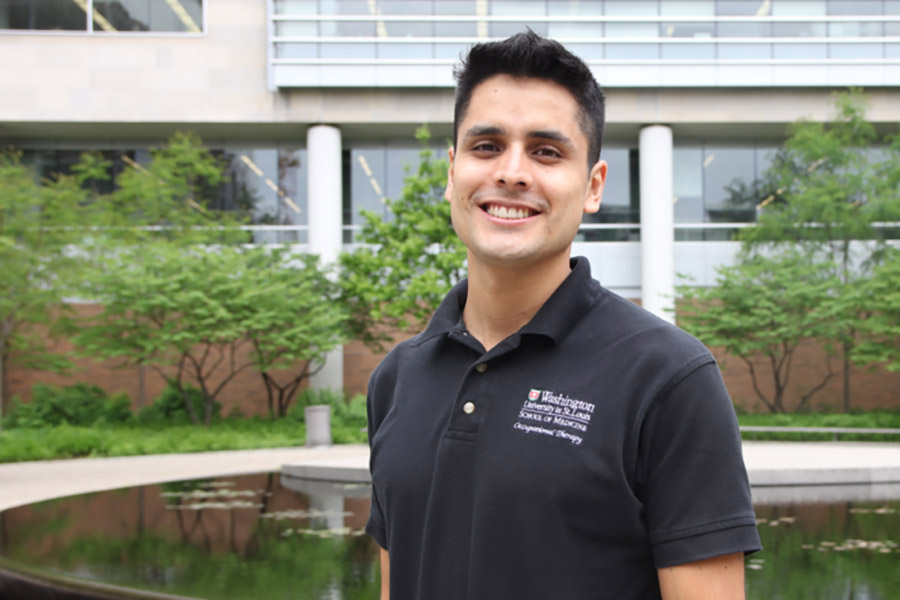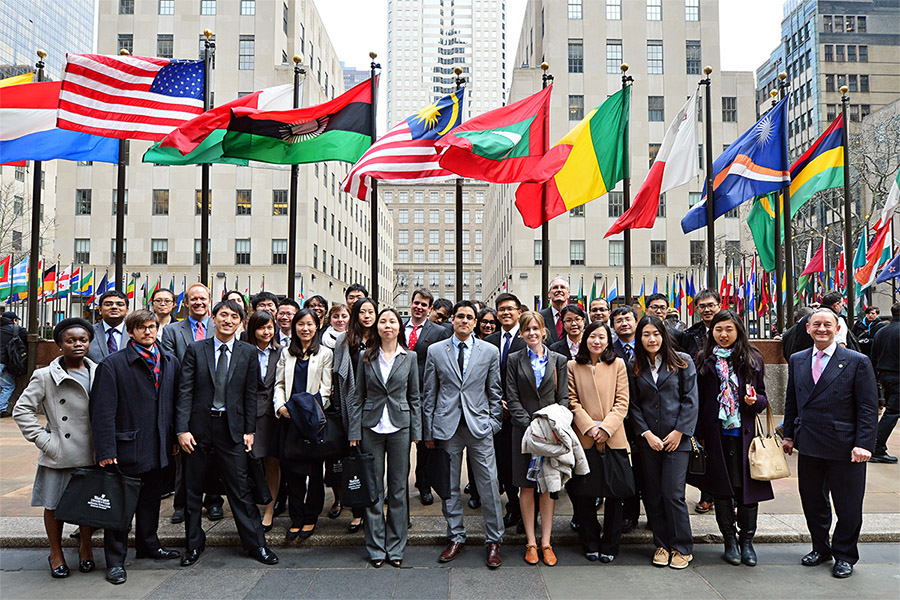Fascinated by the brain, native Chilean pursues advanced degrees in occupational therapy and public health

Juan Pablo Saa visits Ellen S. Clark Hope Plaza on the Medical Campus after presenting his doctoral work at the Program in Occupational Therapy’s Scholarship Day in late April. Photo by Michele Berhorst
When Juan Pablo Saa arrived at Washington University School of Medicine in 2012, he already had the equivalent of a master’s degree in occupational therapy from the University of Chile and 600 hours of clinical practice. But his thirst for knowledge was insatiable, thus his decision to pursue a doctorate in occupational therapy.
His muse, the human brain, first caught his attention in high school.
He recalls his biology teacher lecturing about Nobel laureate Santiago Ramón y Cajal – tagged the father of modern neuroscience – and his studies of the central nervous system. Saa’s teacher told the class that despite the many years scientists had spent studying the system, much of that part of the brain remained a mystery.
“And I thought, ‘That’s my field!’” Saa said. “Because I wanted to get in there and try to solve at least one single little thing, you know?”
Saa sought out Washington University’s Program in Occupational Therapy due to its stellar reputation and became the program’s first student to participate in the McDonnell International Scholars Academy. The academy provides support for international graduate and professional students who are selected based on their promise to become future leaders.
Through the academy, Saa traveled to New York City and Washington, where he met with business leaders, policymakers, grant administrators and other high-ranking professionals to discuss some of the world’s most pressing problems. One of those issues was stroke, the second major cause of death after heart disease.
Saa has studied stroke’s global impact at Washington University, in Chile and in Melbourne, Australia, at the Florey Institute of Neuroscience. His research focuses on how to measure mild cognitive deficits after stroke and what factors affect whether someone will return to work after a stroke.
As people have become more familiar with the signs of stroke, it has resulted in many stroke sufferers being taken to hospitals quickly, resulting in healthier outcomes for such patients, Saa explained.
“But because they have mild deficits, it’s harder for us to detect impairments, especially in the higher-level cognitive realm,” Saa said. “It’s an area that’s like a black box. People are always debating what they want to measure, what they don’t want to measure, or what cognition entails, what it doesn’t entail. There are always these debates about cognition. I’m focusing on that.”
As a doctoral intern in Australia in the fall, Saa compiled literature from the past 10 years on how scientists and clinicians measure cognitive function after stroke. The aim was to work toward proposing the most effective evaluation methods and clinical treatments.
Ideally, though, Saa would like to spend his career using data to prevent strokes. So during his second year in St. Louis, he enrolled in the master’s of public health program at the Brown School while pursuing his doctorate in occupational therapy.
He wanted to learn how to analyze data with a public health perspective since his ultimate goal is to inform public and hospital policy through research.
Saa uses geographical information systems (GIS) to map large amounts of data. For example, he used GIS to map the employment outcomes of stroke patients seen at Barnes-Jewish Hospital. Preliminary results showed that people from poorer ZIP codes in the St. Louis area have a greater chance of having a stroke, especially if the individuals are African-American. His findings also pointed to factors that contribute to patients’ successfully returning to work.
“GIS is a tool that helps policymakers develop better policies based on where people live or different attributes related to those people, such as race or age,” he said.
After graduation, Saa wants to continue using GIS to map patients’ employment outcomes in Australia, where patient data is collected in a centralized database. He also will have access to Singapore’s national health database through the McDonnell Global Stroke Research Initiative.
He’s excited at the possibility of analyzing international data to help address geographic health disparities.
He has accepted a lecturer position at La Trobe University in Melbourne. The university has offered him financial support to earn a doctorate in philosophy, working with top scientists from the Florey Institute.
“People always ask me, ‘When are you going to stop studying and actually start working?’” Saa said, smiling.

As a participant in the McDonnell International Scholars Academy, Juan Pablo Saa traveled to New York City in March 2014. Courtesy Photo
by Allison Braun